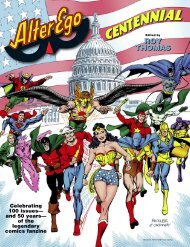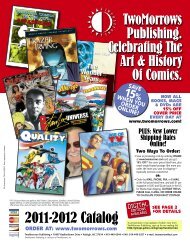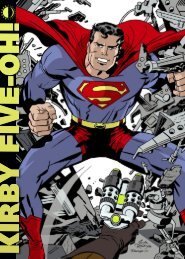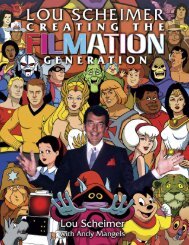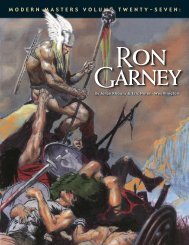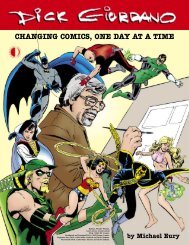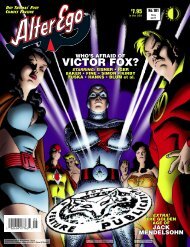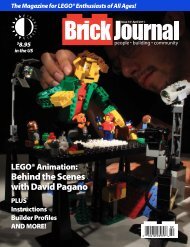Preview - TwoMorrows
Preview - TwoMorrows
Preview - TwoMorrows
Create successful ePaper yourself
Turn your PDF publications into a flip-book with our unique Google optimized e-Paper software.
Cut-Ups Kirby’s Collages In Context<br />
(above) “Just What Is It<br />
that Makes Today’s<br />
Homes So Different, So<br />
Appealing?” by Richard<br />
Hamilton, 1956.<br />
(below) “Compotier avec<br />
fruits, violon et verre” by<br />
Pablo Picasso, 1912.<br />
(right) Rodchenko,<br />
Russian Constructivism.<br />
All collage images TM & ©2012 the<br />
respective owners.<br />
by Steven Brower<br />
TM &©Joe Simon &<br />
Jack Kirby Estates<br />
(This piece originally appeared in Imprint, the daily design blog from Print<br />
magazine, and can be found online at: http://imprint.printmag.com/illustration/jackkirby%E2%80%99s-collages-in-context/<br />
)<br />
Jack Kirby had choices to make, especially considering he could do it all:<br />
writing, penciling, inking, coloring. Along the way he found it prudent to<br />
concentrate on what he could do best: dream big and render those flights of<br />
fancy in graphite. Why then would he choose to break his stride and search<br />
through various magazines in search of the right image, rubber cement in hand?<br />
Kirby’s entrée into the world of collage did not begin with the Fantastic<br />
Four, or even by his own hand. Richard Hamilton included a (Simon &) Kirby<br />
Young Romance splash page in his seminal 1956 collage “Just What Is It that<br />
Makes Today’s Homes So Different, So Appealing?” launching both Pop Art<br />
and Kirby into the fine art world. “High” culture had begun to give<br />
sway to pop culture through the most democratic of<br />
visual art forms, collage.<br />
True, its origins could be traced back to ancient<br />
Japan, and examples exist during the thirteenth century<br />
in Persia, spreading to Turkey and eventually Europe by<br />
the 1600s. The modern version that first captured the<br />
public’s attention was created in 1912, when Pablo Picasso<br />
glued newspaper clippings into a Cubist painting. The<br />
artist’s and general public’s fascination with collage had<br />
begun. Artists of the Russian Constructivist, Bauhaus, Dada<br />
and Surrealist movements pushed the form further. When<br />
Henri Matisse’s eyesight began to fail, he turned to cut paper<br />
collage, producing “Jazz,” celebrating the other 20th century<br />
art form that employed improvisation and spontaneity as a<br />
main ingredient. During the Abstract Impression movement<br />
of the 1950s, Rauschenberg, Reinhart and Motherwell explored<br />
the medium further.<br />
Artists more widely known for their other talents, such as<br />
William S. Burroughs, John Cage and Louis Armstrong all created<br />
collage. In comics, the ever-inventive Will Eisner employed<br />
the technique in The Spirit in “The Story of Gerhard Shnobble”<br />
in 1948. However this featured a single aerial cityscape with<br />
drawn figures and captions on top, to<br />
connote flight, rather than fully realized<br />
collaged elements. If anything, as dramatic<br />
as the effect was, this could be<br />
seen as a shortcut on the part of the<br />
artist, as much time was saved rendering<br />
architecture. Never one to take the easy<br />
way out, Jack Kirby was the first in<br />
comics to utilize collage as entirely<br />
something new and explore its full<br />
potential, despite the crude printing<br />
techniques of the time.<br />
Beginning in 1964 with the<br />
Fantastic Four, Kirby created collages to<br />
convey fanciful scenes of cosmic dimensions.<br />
These early comic collages were<br />
used to further the storytelling and<br />
appear to be created concurrently.<br />
However, according to former assistant<br />
and Kirby biographer Mark Evanier, by<br />
the 1970s Kirby would often create collages from his collection of photographic magazines such<br />
as National Geographic and Life, whenever the mood struck him, and make good use of them at<br />
45



